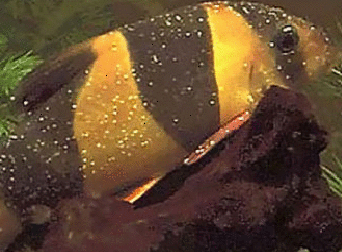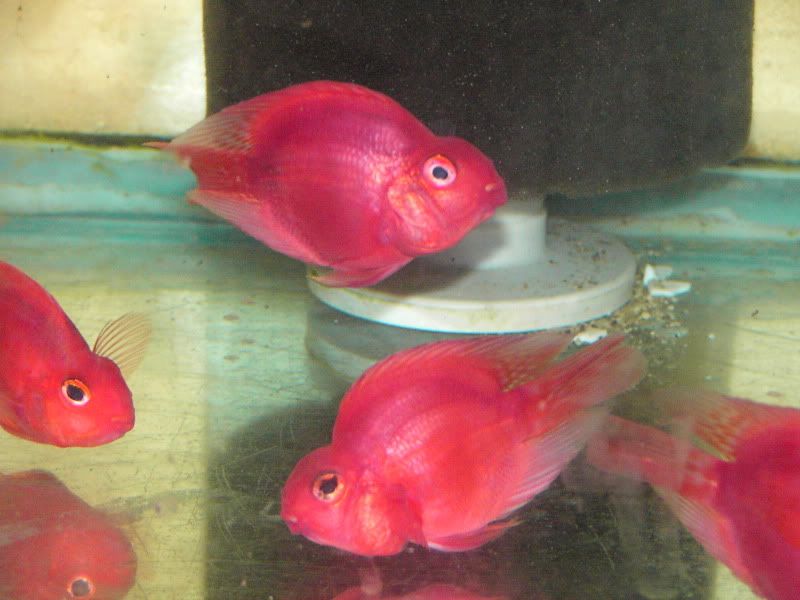
Blood Parrots Facts and Care

Common Names: Blood Parrot Cichlid, Red Blood Parrot, Red Parrot Cichlid, Red Parrot Fish, Parrot Fish.
The Blood Parrot Cichlid is a hybrid fish that was first created in Taiwan in the mid to late 1980's. Its parentage has been highly disputed, but the most commonly speculated pairings are Midas Cichlid (Amphilophus Citrinellus) with the Redhead Cichlid (Paratheraps Synspilum). One of the more wild theories is the Severum (Heros Severus) with the Red Devil Cichlid (Amphilophus Labiatus). Blood Parrots have a round body, a beak shaped head with an upside down triangle mouth. They are often seen in bright orange in coloration, but seen in other colors such as red, yellow, brown, and tan. Other colors have been produced such as green, blue, and purple by dyeing the fish, which shortens life expectancy.

30 Gallons Minimum A good rule of thumb is 30 gallon for one and 10 more gallons for each additional Blood Parrot. As with any fish, the bigger the tank the better.
6 - 9" (15 - 24cm) Blood Parrots grow slow when compared to other Central American Cichlids or Flowerhorn. Once they hit 4-5" their growth slows further. They typically can live anywhere from 5 - 15 years depending on the care given to them and other genetic factors. When Blood Parrots are small they may show a tan/brown body color with black spots near the tail. These are unpeeled juveniles that should change to orange/yellow as it grows.

Some may never change to orange/yellow and stay tan/brown. Lots of Parrots like this are usually sold cheaper than the normal orange ones at places like Petsmart.

Water Conditions
Temperature: 76 - 86F (24 - 30C) pH: 6.0 - 8.5 Temperatures should be between 76 - 86F (24 - 30C) but the ideal temperature should be between 82 - 84F (26 - 29C). Temperatures lower than 80F (24C) seems to cause them to be more reclusive and cause the color to be more pale. The ideal pH should be between 7.0 - 8.0.
Feeding
Blood Parrots enjoy pelleted foods with occasional Blood Worm and Shrimp treats. A smaller pellet size should be used due to their mouths. Recommended pellet brands are Hikari Cichlid or New Life Spectrum Cichlid/Cichlasoma Formula 1 - 3mm depending on the size of the fish. Feeding can sometimes be tricky as some have more deformed mouths than others or gill curl or other gill deformities. If the Parrot has trouble feeding from the surface then it is recommended to switch to a sinking pellet. Thawed shelled peas should be fed once a week to add ruf***e to the diet to help prevent Swim Bladder problems.
Social Behavior
Blood Parrots, especially when young, can be very shy and reclusive. Its typical for them to hide when you first bring them home to hide and/or be very skittish and can take a few weeks for them to adjust to their new surroundings. Some ways for you to help them adjust is to make sure they have several hiding spots and adding some dither fish. Removing hiding spots will only make them more shy and could take longer for them to adjust. Blood Parrots like all Central American Cichlids are territorial and not typically suitable for small community fish. If it fits in their mouth or close then they will try to eat it. Given the proper tank Blood Parrots typically get along fine with most Central and Southern American Cichlids although large overly aggressive cichlids should be avoided as tankmates or house with caution. Due to Blood Parrots deformed mouths they cannot cause much damage to other fish although recently low quality Blood Parrots are being produced to sell at cheaper prices that do not have the deformed mouth and they can do damage.
Health Issues
Stress Spots: This is usually mistaken for Neascus (Black spot disease). Blood Parrots sometimes get Stress Spots which are black splotches on the body or fins and this is caused by stress. This is typically present you bring them home but can also show up when in cases of shyness, bullying, breeding, illness, or sometimes nothing at all. The splotches will usually disappear after awhile once the problem is taken care of.
Swim Bladder Issues: They show an abnormal swimming pattern, may even float upside down or appear to be stuck at the surface of the water, being unable to swim down, or they may lie on the bottom, unable to rise. Fish with a swim bladder disorder will continue to try and feed, showing a normal appetite. This is usually caused by a poor diet. To prevent this from happening it is recommended to feed shelled peas once a week for that days meals. This can also help with mild cases. For severe cases add 1 Tbsp per gallon of Epsom Salt into a container of water. Place the fish in the Epsom Salt bath for 20 - 30 minutes. This can be done twice a day but should only be done as a last resort. Ick/Ich/White Spot: is a common disease of freshwater fish. It is caused by the protozoa Ichtyopthirius. Ick is one of the most common and persistent diseases. Your fish will be covered with white cysts on the skin, fins and gills. Heavily infected fish looks as if they have been sprinkled with sugar and pepper grains. They may scratch themselves against gravel or decorations in the aquarium. Ick is usually deadly if left untreated. To treat ick it is best to first raise to the temperature in the aquarium to 86 - 89F. Then treat the tank with 2 tsp of salt per gallon of water or treat the water with Mardel CopperSafe. Any other treatment can potentially damage the Biofilter so other treatments are not recommended. During treatment it is not recommended that you change the water so before you treat the tank a 25 - 50% water change is recommended. Treatment should take 1 - 2 weeks depending on severity.

Sexual Differences
Blood Parrots are not sexually dimorphic which means you can not look at one and be able to sex it. The only proper why to tell the gender is to vent them.

Breeding
Blood Parrots will start to pair off and breed around 2 - 3" (5 - 7.5cm). Nearly all male Blood Parrots are sterile which means they can not fertilize the eggs. Female Blood Parrots however can cross with any male Central American Cichlid or Flowerhorn Cichlid and the eggs be viable. South American Cichlid (except Cichlasoma Festae) and African Cichlid can not cross with female Blood Parrots. If the eggs turn white then they are no good and should be removed to prevent dirtying the water. Good eggs should turn tan with a black dot and hatch after 2-4 depending on water temperature.
Dyed and Mutilated Parrots
Blood Parrots and many other fish have been the victims of cruel cosmetic surgery where the fish is dyed or mutilated in order to "enhance" its beauty at the cost of greatly shortening its life span. These type of fish should never be purchased. Dyeing: Dyeing (also known as artificial coloring or juicing), is achieved by a number of methods, such as tattooing, injecting the fish with a hypodermic syringe containing bright fluorescent color dye and dipping the fish into a dye solution among others. This process is usually done to make the fish a brighter color and more attractive to consumers. The coloring of the fish is not permanent, and usually fades away in six to nine months.


These fish are usually referred to as Green/Blue/Purple Parrots, Jellybean Parrots and Bubblegum Parrots. Amputation: Amputation is perhaps the worst and most inhumane method of cosmetic fish surgery. Its victims are usually Blood Parrots and Flowerhorn. The fish's tail is cut off with scissors while at a young age so as it grows the body produces a sort of "heart" shape as it grows.


These fish are usually referred to as Heart Parrots and Love Parrots.
Parrot Identification
Blood Parrots: Blood Parrots have a round body, a protruding beak like head, and an odd shaped mouth that does not close. They are seen in orange, yellow-orange, and red-orange.

Low Quality Blood Parrots: Recently there has been lots of low quality Blood Parrots showing up in the market at stores like Petco, Petsmart, Walmart, and some local stores at significantly lower prices than they are typically seen. These Parrots are low quality in the way the ideal Blood Parrot should look like. These low quality parrots are being mistaken as King Kong Parrots because they posses normal closing mouths rather than the upside down triangle mouth and they do not posses the hump like body.
King Kong Parrots: King Kong Parrots are a different breed of Blood Parrots. They typically have a more oval shaped body, less protruding head, and they have normal closing mouth. They grow larger than Blood Parrots, usually 7 - 12", and are typically more aggressive. They are seen in orange and red-orange.

Dyed Blood Parrots: These are often called Jellybean or Bubblegum Parrots, but are just dyed Blood Parrots. They are also confused as being a hybrid of Blood Parrot and Pink Convict which is not the case. These fish should be not be purchased.



Dyed/Undyed Shortbody Pink Convicts: These are usually called Jellybean Parrots but they do not have any Blood Parrot DNA in them. They are just shortbody or sometimes normal bodied Pink Convicts. They are usually dyed but can be found undyed.


Kilin Parrots: Sometimes called Kilin Parrot, Kirin Parrot, or Flowerhorn Parrot are a hybrid between Blood Parrots and Flowerhorn. They have the body shape and mouth of a Blood Parrot and the body color and markings of a Flowerhorn.



